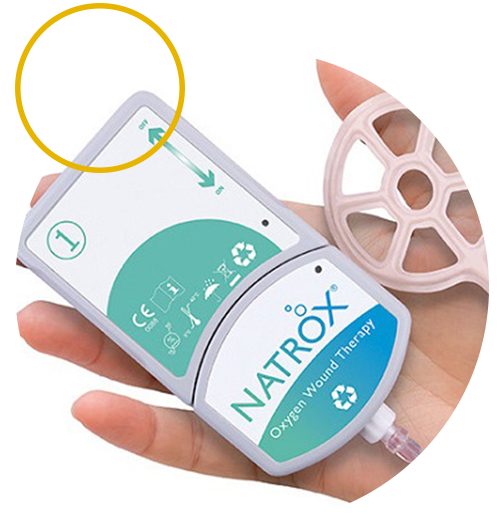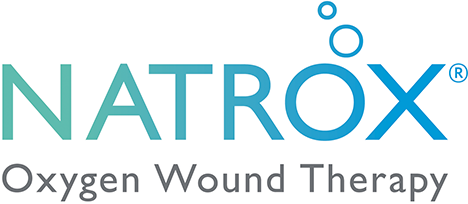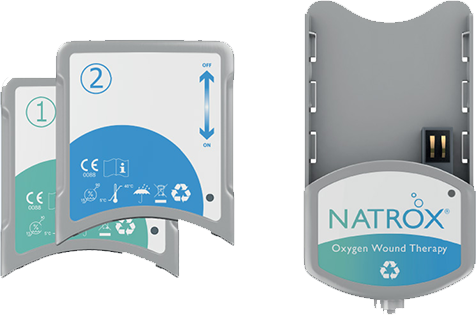
NATROX® extracts oxygen from the air, and delivers it through a thin flexible tube, which is in direct contact with the wound surface. This continuous supply of oxygen ensures an oxygen rich environment around the wound area. NATROX® is silent with no sensation of movement while providing a continuous flow of pure humidified oxygen. Oxygen is an essential component for the maintenance of healthy tissue and for all the processes involved in wound healing, such as oxidative killing of bacteria, migration of skin cells and the formation of new blood vessels.

NATROX® is a small portable device about the size of a mobile phone. Its function is to produce concentrated oxygen from the surrounding air, and pass this down a thin flexible tube and pass this down through the ODS so it can be diffused evenly across the wound bed.
Research shows that without the correct levels of oxygen in the tissues, it is very difficult for wounds to heal. The tissues get oxygen from two main sources; firstly from the blood supplied through capillaries, and secondly, the wound can get some oxygen from the atmosphere.
The NATROX® Battery, 2 batteries are supplied, one is fitted to the NATROX® device whilst the other is left on continuous charge. The NATROX® Oxygen Generator (OG), activation occurs when a fully charged battery is fitted. Flashing green light indicates oxygen is flowing. The NATROX® Oxygen Delivery System (ODS) is a sterile, single use oxygen delivery system. Connects to the OG providing oxygen directly to the wound bed.
The Natrox Oxygen Wound Therapy treatment allows for mobility of patients. You can go about your daily activities while the wound gets the maximum amount of oxygen delivered to the wound.

NATROX® is a small portable device about the size of a mobile phone. Its function is to produce concentrated oxygen from the surrounding air, and pass this down a thin flexible tube and pass this down through the ODS so it can be diffused evenly across the wound bed.
Research shows that without the correct levels of oxygen in the tissues, it is very difficult for wounds to heal. The tissues get oxygen from two main sources; firstly from the blood supplied through capillaries, and secondly, the wound can get some oxygen from the atmosphere.

The NATROX® Battery, 2 batteries are supplied, one is fitted to the NATROX® device whilst the other is left on continuous charge. The NATROX® Oxygen Generator (OG), activation occurs when a fully charged battery is fitted. Flashing green light indicates oxygen is flowing. The NATROX® Oxygen Delivery System (ODS) is a sterile, single use oxygen delivery system. Connects to the OG providing oxygen directly to the wound bed.
The Natrox Oxygen Wound Therapy treatment allows for mobility of patients. You can go about your daily activities while the wound gets the maximum amount of oxygen delivered to the wound.

If you or the person you are caring for has a diabetic foot wound or ulcer that is open and is having difficulty healing, you can come in for an assessment.

Make An Appointment by clicking here.

Assessment with our doctors who are specialists in wound healing.

If you are prescribed the Topical Oxygen Therapy for your wound, you will be taught how to use it and how to care for your wound.

Follow-ups with home nursing option

Better quality of life with closing wound
A diabetic foot ulcer is an open sore or wound that occurs commonly located on the bottom of the foot. Of those who develop a foot ulcer, hospitalised can occur due to infection or other ulcer-related complication.This can sometimes lead to amputation of the limb if not treated.
Venous ulcers are caused by increasing pressure in the veins. These typically occur on the lower leg and results in blood pooling. These kind of wounds are very slow to heal, usually because of weak blood circulation in the limb. They can last anywhere from a few weeks to years.
A pressure ulcer is a localised injury to the skin. It may be caused by limited mobility, poor nutrition, comorbidities, aging skin or friction and moisture.
Read about how other patients have handled their diabetic wounds, the treatments they sought and how they are doing today.
A diabetic foot ulcer is an open sore or wound that occurs commonly located on the bottom of the foot. Of those who develop a foot ulcer, hospitalised can occur due to infection or other ulcer-related complication.This can sometimes lead to amputation of the limb if not treated.
Venous ulcers are caused by increasing pressure in the veins. These typically occur on the lower leg and results in blood pooling. These kind of wounds are very slow to heal, usually because of weak blood circulation in the limb. They can last anywhere from a few weeks to years.
A pressure ulcer is a localised injury to the skin. It may be caused by limited mobility, poor nutrition, comorbidities, aging skin or friction and moisture.
Read about how other patients have handled their diabetic wounds, the treatments they sought and how they are doing today.